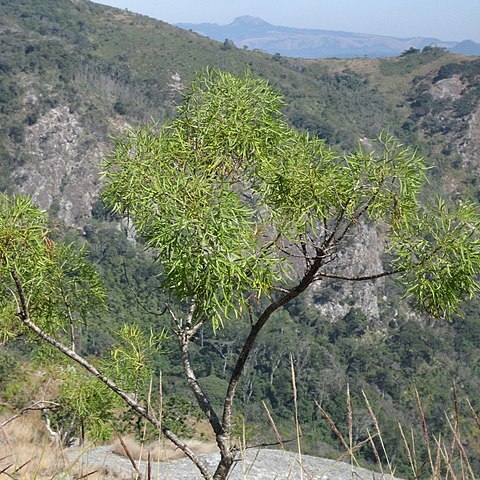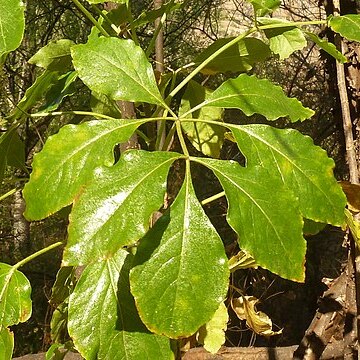Shrub, 0.8-1.9 m high, or small tree, 2-5 m high, or woody liana. Leaves simple or trifoliolate to pinnately and/or pedately compound with up to 7 leaflets; leaflets elliptic-lanceolate to ovate or obovate, entire to crenate. Flowers in bracteate compound umbels, greenish white. Flowering time Dec.-Mar. (‘Valley Thicket/Scarp Forest form’ flowers sporadically all year with a peak in Oct.). Fruit outline elliptic to somewhat obpyriform, slightly winged; mericarps of 2 forms, one 2-winged, the other 3-winged, mostly flattened, with prominent ribs; vittae 6, with 2 on face and 4 around each seed; carpophore bipartite.
Shrub or small tree, 2-9 m, bark smooth, reddish, peeling in waxy flakes. Leaves palmately or pinnately 1-3(-9)-foliolate, leaflets elliptic-lanceolate, crenulate. Flowers in compound umbels, greenish white. Fruit elliptic, mericarps isodiametric, heteromorphic, one with 2 marginal and 1 median wing, other with only 2 lateral wings, sometimes pilose, vittae present, rib oil ducts inconspicuous.
Shrub or small tree, 2-9 m tall, with reddish or translucent, peeling bark. Leaves palmately or pinnately 1-3(-9)-foliolate, leaflets elliptic-lanceolate, crenulate. Flowers greenish white. Fruit elliptic, mericarps isodiametric, heteromorphic, one with 2 marginal and 1 median wing, the other with only 2 lateral wings, sometimes pilose, vittae present, rib oil ducts inconspicuous.
The form described from the Cape Province of South Africa has all the leaves simple and entire.. Forms with most upper leaves entire are not infrequent in N. Kenya and Uganda.



